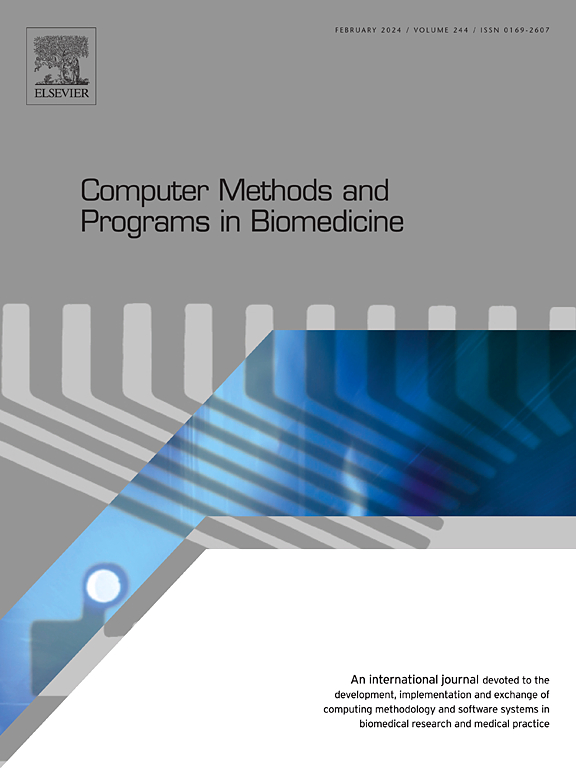SmartAlert: Machine learning-based patient-ventilator asynchrony detection system in intensive care units
IF 4.9
2区 医学
Q1 COMPUTER SCIENCE, INTERDISCIPLINARY APPLICATIONS
引用次数: 0
Abstract
Background and Objective
Patient-ventilator asynchronies (PVA) are associated with ventilator-induced lung injury and increased mortality. Current detection methods rely on static thresholds, extensive preprocessing, or proprietary ventilator data. This study aimed to develop and validate a fully online, real-time system that detects and classifies PVAs directly from ventilator screen data while alerting clinicians based on severity.
Methods
The SmartAlert system was developed using ventilator screen recordings from ICU patients. It extracts pressure and flow waveforms from video recordings, converts them into time-series data, and employs deep neural networks to classify asynchronies and assign alarm levels from no urgency to most urgent. A dataset of 381,280 double-breath units was independently annotated by two expert intensivists. Two deep learning models were trained: one for alarm prediction and another for asynchrony classification (ineffective triggering, double cycling, high inspiratory effort, no asynchrony). Performance was evaluated using accuracy, sensitivity, specificity, and AUC-ROC, compared to expert consensus.
Results
SmartAlert demonstrated strong performance for alarm level prediction (overall accuracy: 83.8 %, weighted AUC-ROC: 0.943 [95 % CI: 0.941–0.945]) and PVA classification (weighted accuracy: 89.3 %, weighted AUC-ROC: 0.951 [95 % CI: 0.950–0.953]). It showed high specificity for urgent alarms (99.9 % for level 3) and PVA types (98.5 % for ineffective triggering, 96.9 % for double cycling, 94.8 % for high inspiratory effort).
Conclusions
We developed and internally validated SmartAlert, an automated system that detects PVAs, classifies severity, and alerts clinicians in real time. Its potential to reduce alarm fatigue, optimize ventilator settings, and improve patient outcomes remains to be tested in clinical trials.
SmartAlert:重症监护病房中基于机器学习的患者-呼吸机同步检测系统
背景与目的患者-呼吸机不同步(PVA)与呼吸机诱导的肺损伤和死亡率增加有关。目前的检测方法依赖于静态阈值、广泛的预处理或专有的呼吸机数据。本研究旨在开发和验证一个完全在线的实时系统,该系统可以直接从呼吸机屏幕数据中检测和分类pva,同时根据严重程度提醒临床医生。方法利用ICU患者的呼吸机屏幕记录,开发SmartAlert系统。它从视频记录中提取压力和流量波形,将其转换为时间序列数据,并使用深度神经网络对异步进行分类,并将警报级别从不紧急分配到最紧急。381,280双呼吸单位的数据集由两名专家独立注释。训练了两个深度学习模型:一个用于警报预测,另一个用于异步分类(无效触发、双循环、高吸气力、无异步)。与专家共识相比,使用准确性、敏感性、特异性和AUC-ROC来评估性能。结果smartalert在报警等级预测(总体准确率:83.8%,加权AUC-ROC: 0.943 [95% CI: 0.941 ~ 0.945])和PVA分类(加权准确率:89.3%,加权AUC-ROC: 0.951 [95% CI: 0.950 ~ 0.953])方面表现出较强的性能。它对紧急警报(3级99.9%)和PVA类型(无效触发98.5%,双循环96.9%,高吸气力度94.8%)具有高特异性。我们开发并内部验证了SmartAlert,这是一种自动化系统,可以检测pva,对严重程度进行分类,并实时提醒临床医生。它在减少报警疲劳、优化呼吸机设置和改善患者预后方面的潜力仍有待临床试验的检验。
本文章由计算机程序翻译,如有差异,请以英文原文为准。
求助全文
约1分钟内获得全文
求助全文
来源期刊

Computer methods and programs in biomedicine
工程技术-工程:生物医学
CiteScore
12.30
自引率
6.60%
发文量
601
审稿时长
135 days
期刊介绍:
To encourage the development of formal computing methods, and their application in biomedical research and medical practice, by illustration of fundamental principles in biomedical informatics research; to stimulate basic research into application software design; to report the state of research of biomedical information processing projects; to report new computer methodologies applied in biomedical areas; the eventual distribution of demonstrable software to avoid duplication of effort; to provide a forum for discussion and improvement of existing software; to optimize contact between national organizations and regional user groups by promoting an international exchange of information on formal methods, standards and software in biomedicine.
Computer Methods and Programs in Biomedicine covers computing methodology and software systems derived from computing science for implementation in all aspects of biomedical research and medical practice. It is designed to serve: biochemists; biologists; geneticists; immunologists; neuroscientists; pharmacologists; toxicologists; clinicians; epidemiologists; psychiatrists; psychologists; cardiologists; chemists; (radio)physicists; computer scientists; programmers and systems analysts; biomedical, clinical, electrical and other engineers; teachers of medical informatics and users of educational software.
 求助内容:
求助内容: 应助结果提醒方式:
应助结果提醒方式:


